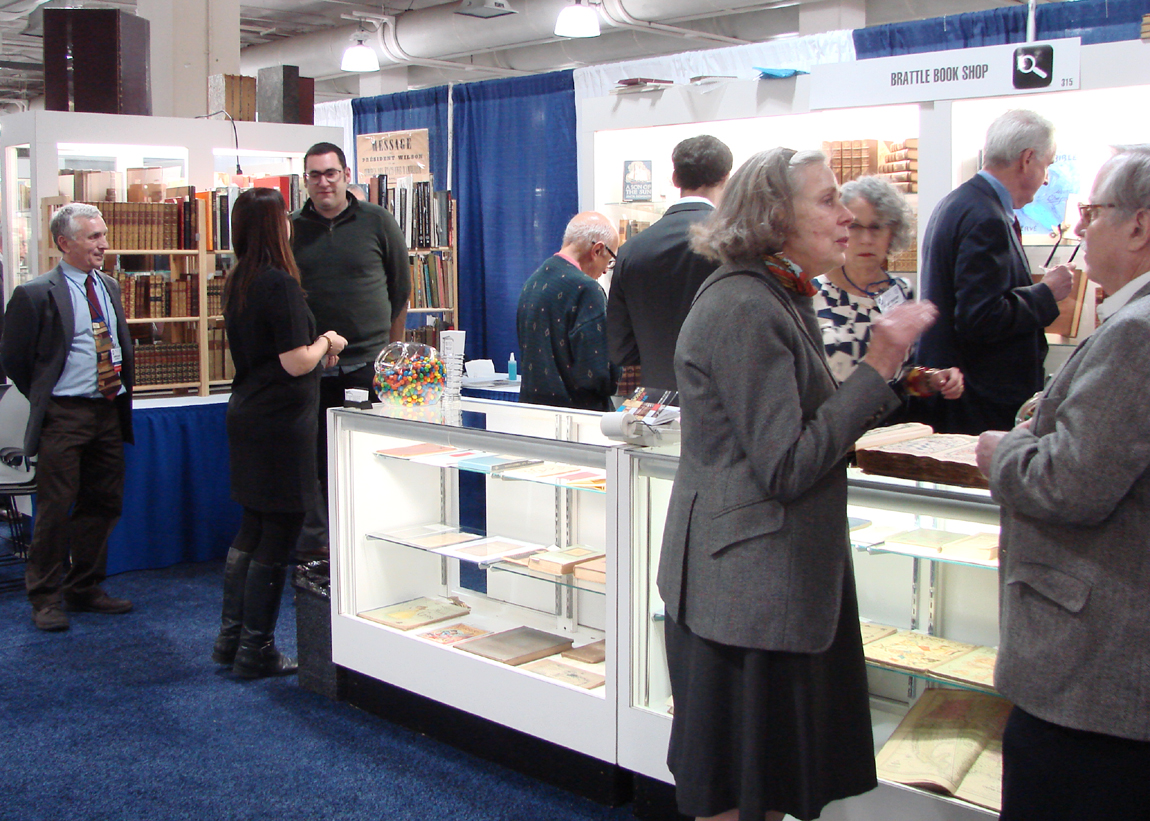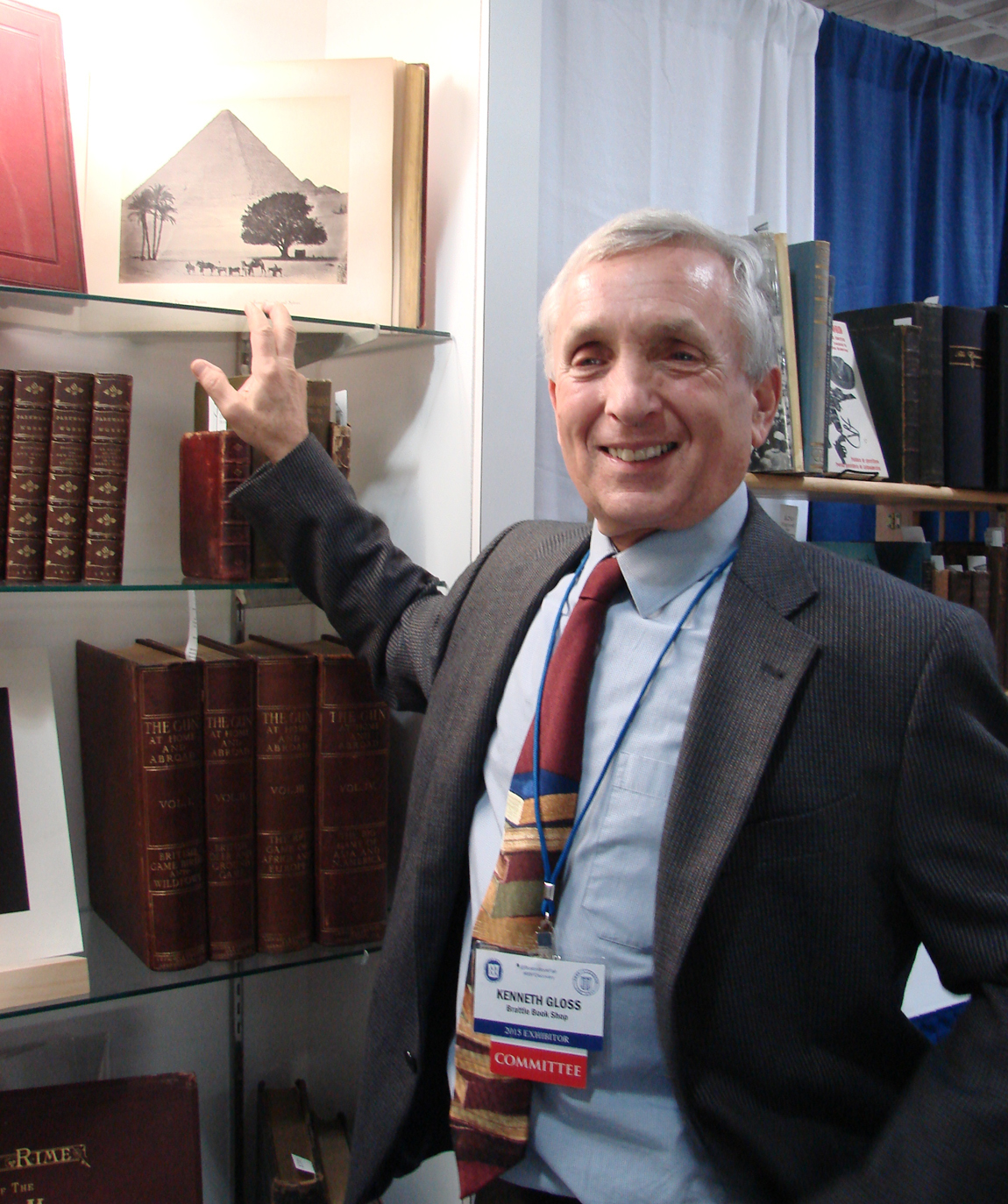Review and Photos by Rick Russack
BOSTON, MASS. — Now in its 39th year, the Boston International Antiquarian Book Fair presented its 2015 edition at the Hynes Auditorium November 13–15, drawing large crowds. With dealers from distant states and numerous foreign countries, there was rare and not-so-rare stuff for all. There were dealers from 11 countries, including England, Germany, the Netherlands, Russia, France, Spain, Australia and Denmark, as well as from California, Virginia and other parts of the United States.
Attendees could find books on almost every conceivable subject: Africa, Western Americana, books about books, baseball, art, children’s books, mystery, first editions, early printed books, cooking, literature, as well as autographs, photographs, maps and just about anything else you can think of. When the show opened at 5 pm on Friday, the room immediately filled up with buyers seeking out their favorite dealers, and dealers began writing up sales almost immediately.
There is something special about book fairs. Things that are usually behind lock and key in rare book libraries are displayed on tables and in open showcases. You can handle a letter written by George Washington or Abraham Lincoln and you can handle books dating back to the Sixteenth Century or earlier. You can look closely at rare maps or ephemeral pieces of American history, sometimes knowing that what you are holding may be the only surviving example.
You can talk to specialist book dealers from all over the world and learn as they answer your questions about a book or manuscript. Many of the dealers have priced and illustrated catalogs of their inventory that are free to all. In almost all cases, the books are described in detail; these catalogs are an education by themselves and many people collect early book seller catalogs.
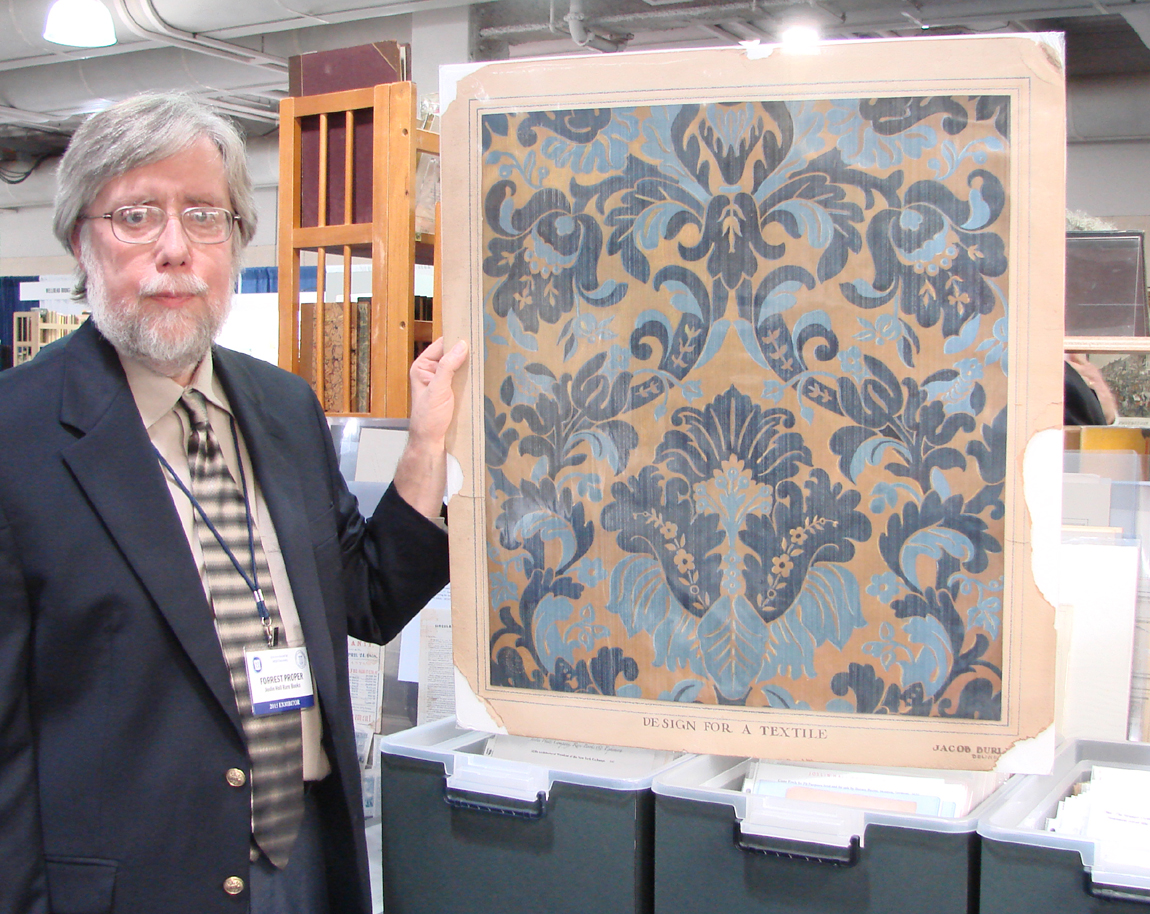
Forrest Proper, Joslin Hall Rare Books, Northampton, Mass., had several pieces of original art work by Jacob Burley (1878-1942). He designed furniture, stained glass, etc.
Several dealers had important autographs and historical documents. A letter from Abraham Lincoln to Secretary of War Edwin Stanton discussing transport of troops, which Lincoln was very concerned about, was in the booth of University Archives, Westport, Conn., priced at $95,000. The dealer also had a letter on White House stationery, written by Harry Truman on his first day in the Oval office the day after President Franklin Delano Roosevelt died. It was priced at $20,000. A letter from Lee Harvey Oswald to his brother was available for $9,000. Seth Kaller, White Plains, N.Y., had a 1756 letter written by George Washington discussing the forts he built to protect the Virginia frontier, $24,000. Ken Lopez, Hadley, Mass., offered a letter from Harper Lee to a reader of To Kill A Mockingbird for $4,500.
Collectors of Western Americana had an amazing selection of books to peruse. Frederik Muller from Holland had a first edition of George Catlin’s North American Indian portfolio with beautiful, hand colored plates at $150,000. This portfolio was published about 1845, and Catlin’s scenes are among the earliest and most realistic images of the Western tribes. It was displayed on a table for anyone to view.
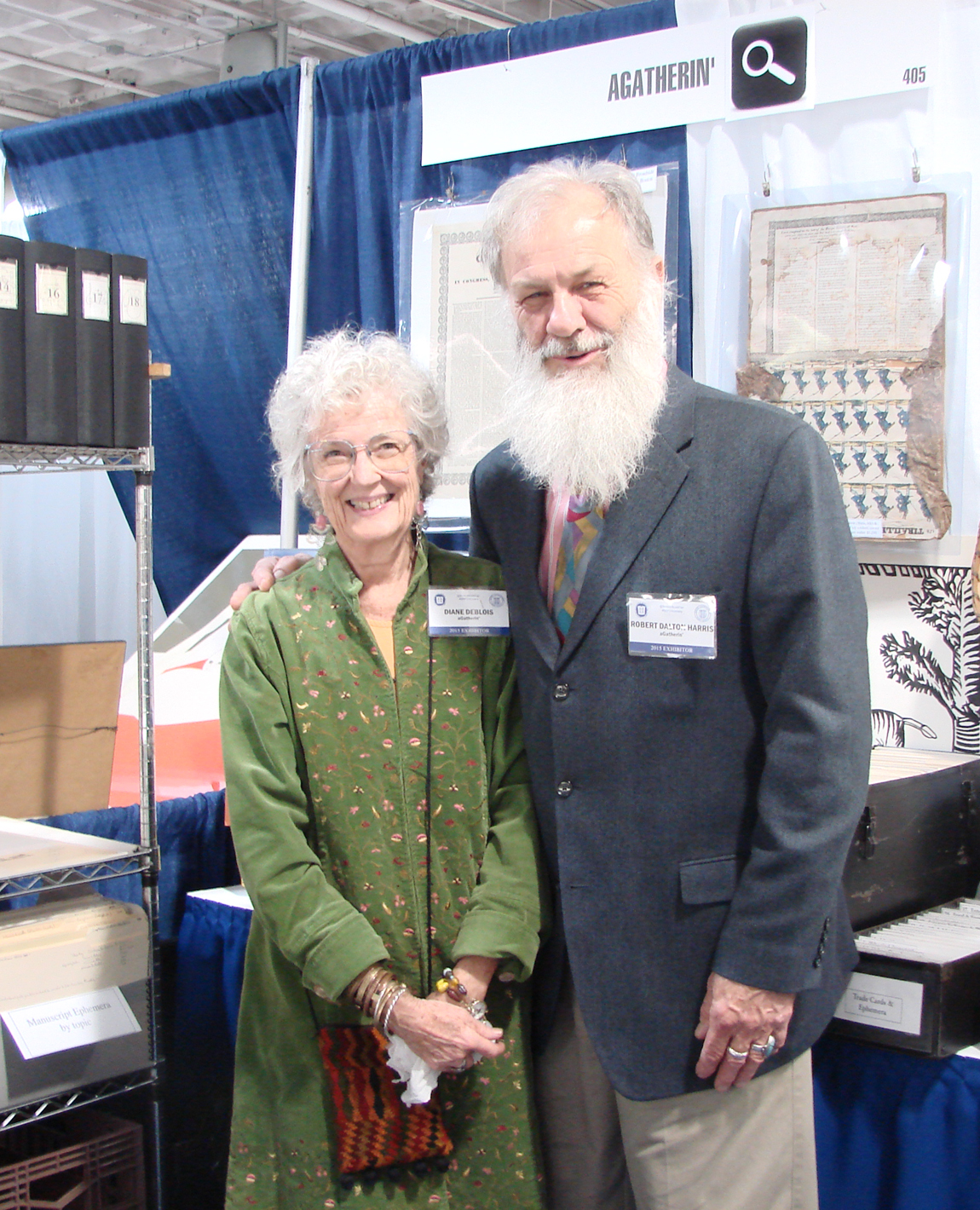
Diane DeBlois and Bob Dalton, known as aGatherin’, West Sand Lake, N.Y., have done all 39 shows. They are known for ephemera.
William Reese, New Haven, Conn., can always be counted on to have outstanding Americana. Included was an unrecorded, pre-Revolution broadside attacking Massachusetts Governor Thomas Hutchinson and British Solicitor General Alexander Wedderburn for their attack on Benjamin Franklin. It was illustrated with an engraving of the burning of an effigy of Hutchinson and was priced at $25,000. The description of the item in Reese’s catalog was a full page.
Another offering was described in three full pages in the catalog. It was the original manuscript journal by John Lacey Jr detailing his 1773 expedition to the Delaware Indians and his 1776 Canadian campaign, together totaling about 15,000 words. It included his contentious relationship with General “Mad” Anthony Wayne. Reese was asking $75,000. He also had a copy of Lieutenant General Burgoyne’s account of his defeat at Saratoga, published in 1780, bound in modern leather, for $6,000.
Cookbook collectors found plenty of temptations at Rabelais, Inc, Biddeford, Maine, specialists in cookbooks, menus, recipe manuscripts, books on dining etiquette and culinary ephemera. Many chefs are among the firm’s clients. The selection included the definitive text on Southern cooking, The Unrivalled Cook Book by a Mrs Washington, published in 1886. It included more than 200 Creole recipes; including one for boiled peanuts, $1,500. For the thirsty, the dealer had a second edition of Modern American Drink: How to Mix and Serve All Kinds of Cups and Drinks. It was written by George Kappeler, published in 1902, with 120 pages and priced at $500. Also on offer was Mary Whitcher’s Shaker House-Keeper. It is considered the earliest cookbook in Shaker culinary literature and the asking price was $750.
Liber Antiquus, Chevy Chase, Md., specializes in early books and manuscripts. Here could be found a bound volume with ten 1715 almanacs, including one of the very first published especially for women, The Ladies Diary: or the Woman’s Almanack for the Year of Our Lord, 1715. It contained “many delightful and entertaining particulars, peculiarly adapted for the use and diversion of the fair-sex.” The bound volume was priced at $6,500. A Catholic rites calendar for the year 1684, published during the reign of Pope Innocent XI, was $3,500. Among other things, it instructed Roman cardinals in what color vestments were to worn on each day and which services were to be performed. Offered, too, was a 1687 edition of Chaucer’s Canterbury Tales, bound in contemporary leather, for $8,500.
Douglas Stewart, Melbourne, Australia, had a fascinating children’s game based on Daniel Defoe’s Robinson Crusoe. Published in 1830, it was a single-sheet woodcut with a central illustration based on the book, surrounded by 20 other illustrations. It was a “race”-type game where the object was to move around the board based on a throw of dice. It was printed in the Netherlands and the text was in Dutch. These kind of games had been published in Europe since the Sixteenth Century, but games for children did not appear in America until the second quarter of the Nineteenth Century. Stewart priced William Bligh’s 1790 account of the mutiny on his ship, the Bounty, at $3,600. It was Bligh’s side of the story, and, as many may recall, the British Admiralty sent a warship to apprehend Fletcher Christian and his fellow mutineers.
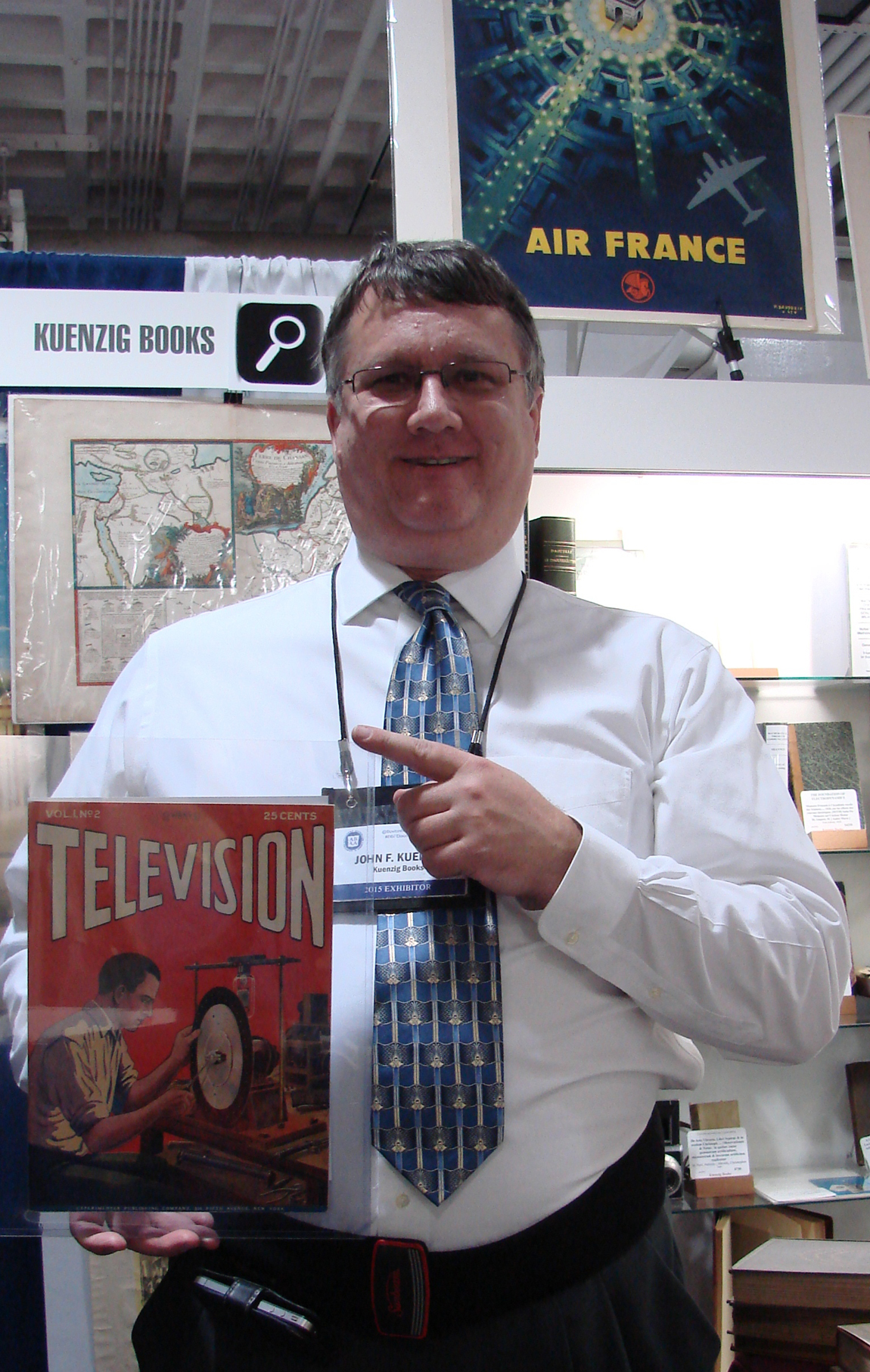
John Kuenzig, Topsfield, Mass., specializes in books about science and technology. He is shown here holding a copy of Television magazine, published in 1928. It’s one of the earliest publications about television and was only produced for two issues.
There were first editions for every taste and pocketbook. A first edition set of the four Winnie-the Pooh books by A.A. Milne was priced at $15,000 by Ken Sanders, Salt Lake City, Utah. Raptis Rare Books, Brattleboro, Vt., had some first editions of the James Bond books, including a copy of The Man With The Golden Gun, signed by Roger Moore (who played Bond in that movie), priced at $1,500. Ken Lopez had a first American edition of Henry James’s The Ambassadors for $450 and a first edition of a Van Dine Philo Vance mystery The Gracie Allen Murder Case, at the same price. He also had a first edition of James Michener’s Iberia, 1968.
If one’s special interest is sporting books, L&T Respess, Northampton, Mass., might have had some titles of interest. Shotgunning in the Uplands by Ray Holland was $150. The edition was limited to 250 copies and this one was signed by the author and illustrator. The dealer had a copy of Rudyard Kipling’s first American edition of Collected Dog Stories priced at $300. For the golfer in the family, there was a circa 1912 album of photographs of golfing at the Equinox House, Manchester, Vt., Manchester in the Mountains, Vermont, at $1,500.
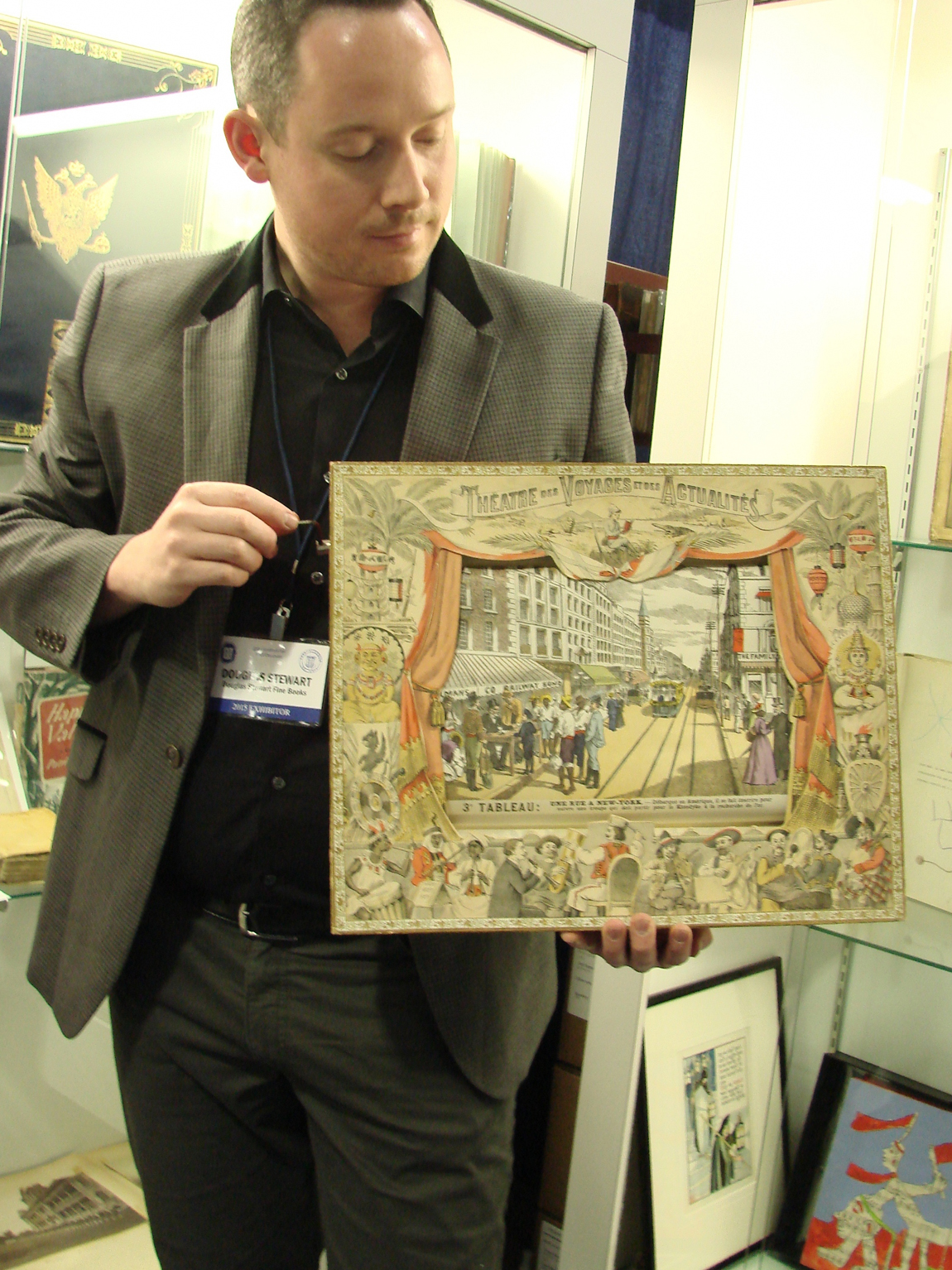
Douglas Stewart, Melbourne, Australia, had a large, rare panorama, “Voyage autour du monde un petit Francais, (Travel Around The World by a Young Frenchman).” It was produced in Paris, circa 1905 by Lucien Maucler. As it unrolls, it chronicles the adventures of a young boy as he travels around the world. Panoramas are usually much smaller than this one, which was priced at $12,000.
As was mentioned earlier, this was the 39th year of this show. Perhaps a measure of the quality of the show is the fact that six of the current exhibitors have done all of the shows. After the show, Ken Gloss, chairman of the show committee, told Antiques and The Arts Weekly that most dealers had done quite well. He is one of the exhibitors that has done all the 39 shows and he has been on the show committee each year. “I think everyone had a good show,” he said. “I’m usually the person who hears complaints and I didn’t hear many this time. We had a good crowd Friday night when the ‘regulars’ were in and we had good crowds both Saturday and Sunday. Marsha Bernko, executive producer of the Antiques Roadshow, put on a program where she gave a behind-the-scenes talk about the program. It was very well attended and I think it probably drew in some people who might not otherwise have come to the show.
“The cross-promotion with Marv Getman’s show is good,” he continued. “The Skinner book auction helps draw people to Boston, and letting them know about all the themed exhibits in Boston helps to make it into a major event — kind of ‘we have to go.’ And the other way that I gauge how well the show did is that most dealers told me they’ll be back next year.”
Book fans will be able to browse the show a little earlier next year as it will take place October 28–30. For information, www.bostonbookfair.com.

